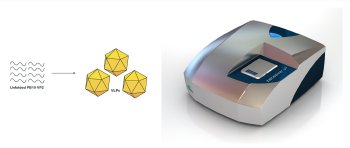Using the Zetasizer µV dynamic light scattering (DLS) system from Malvern Panalytical, Professor Mario L. Calcagno and his team at the Biochemistry Department of the Faculty of Medicine, Universidad Nacional Autónoma de México (UNAM, the National Autonomous University of Mexico) have been able to distinguish allosteric transition [structural rearrangements] in a single E. coli protein.
 The Zetasizer µV dynamic light scattering (DLS) system from Malvern Panalytical.
The Zetasizer µV dynamic light scattering (DLS) system from Malvern Panalytical.
Characterizing protein allostery is challenging because of its sensitivity to experimental conditions, however, a quantitative description of allosteric transition is important in understanding and controlling metabolic and other biochemical processes.
"We use the Zetasizer µV to characterize the size of proteins and how they interact to produce multimeric forms or even supramolecular arrangements of the protein such as viral capsids [shells]," said Dr Ismael Bustos-Jaimes, from Laboratory of Physical Chemistry and Protein Engineering at UNAM commented "The Zetasizer µV allows us to work with sizes in the range of 1 nm to 500 nm and follow each assembly and stability parameter, such as pH, temperature and ionic strength, guiding us to the optimal production conditions for these virus-like particles."
"The sensitivity of the Zetasizer µV has additionally allowed my colleague, Prof Calcagno, to analyze allosteric transitions" explained Dr Bustos-Jaimes. "The size of the hexameric glucosamine-6-phosphate deaminase protein from E. coli changes its shape to a more compact form upon allosteric-activator binding, and this change can be measured."
"The Zetasizer µV software is user-friendly and in addition to measuring particle size it delivers information about the quality of sample preparation. This is very important when you work with molecules which are prone to uncontrolled aggregation," said Dr Bustos-Jaimes.
The UNAM team studies allosteric transitions and the assembly of virus-like particles (VLPs) for use in diagnostics and disease control. VLPs are biological nanoparticles that resemble natural viruses but contain no genetic material. As non-infective agents, they are suitable for use in the analysis of viral infection mechanisms, vaccine production, tissue-specific drug delivery and as biological nanomaterials.